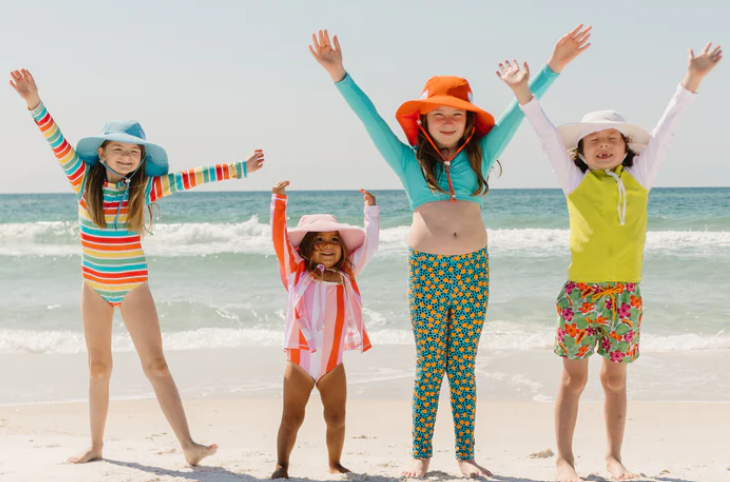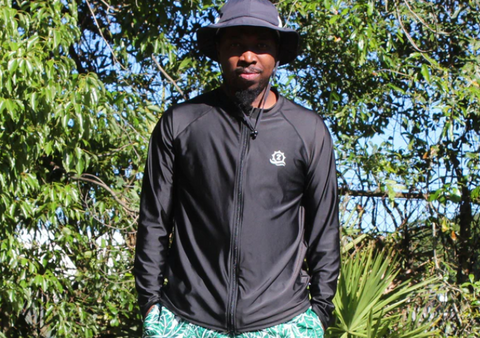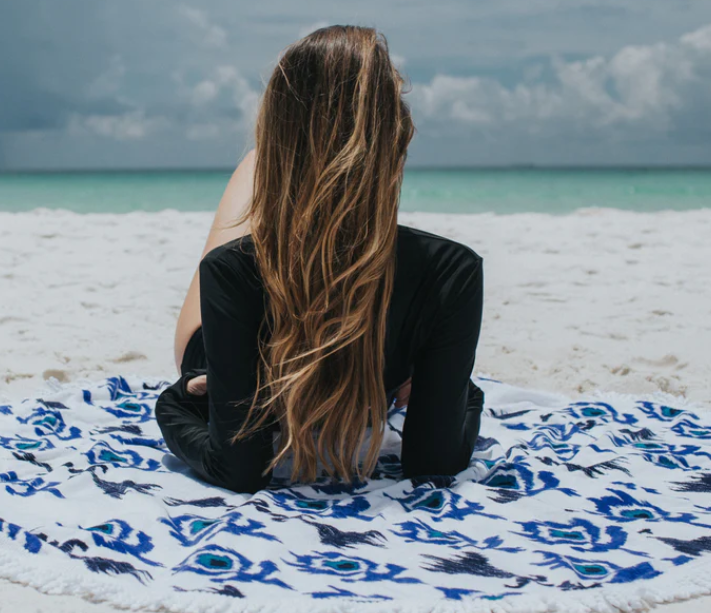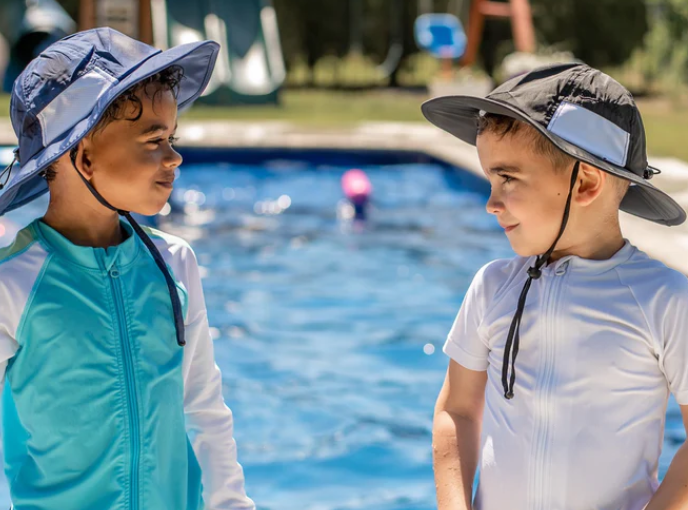
How long to tan in the sun
Most people tan within 1 to 2 hours, but factors like skin type, weather conditions, and the time of day will play a role. Burns and color may take time to develop, so don't assume you're not tanning if you don't see immediate results.
Remember, tanning poses risks for skin damage and other complications like sun poisoning and skin cancer. Always use proper sunscreen (or at least tanning oil with some SPF).
Quick links:
Why are safe tanning practices important?
How to optimize your tan safely
Importance of safe tanning practices
You should practice safe tanning because any amount of ultraviolet (UV) exposure damages your skin over time. While some tanning can boost vitamin D levels or give your skin that sun-kissed glow, extensive exposure, and sun damage accelerates skin aging and increases cancer risk.
Proper precautions make tanning safer short-term and long-term. Smart tanning means you:
- Understand your skin type’s sensitivity
- Monitor local UV forecasts
- Limit exposure durations
- Use proper sunscreen and protective UPF wear
- Carefully watch for problems afterward
Learn about the signs and symptoms of melanoma and get annual screenings to ensure early detection if issues arise. Spotting unusual changes promptly makes treatment more successful.
Moderate tanning with preventive measures reduces the hazard without eliminating it fully. Prioritizing safe tanning practices protects your skin and natural appearance for years to come. When you choose to tan, keep yourself safe from excessive UV light exposure to reduce the risk of any kind of skin damage.
Understand your skin type
The key to safe tanning is knowing your skin type and your skin’s sensitivity to sun exposure. The Fitzpatrick scale categorizes skin into six phototypes based on melanin levels (skin color).
- Type I (pale white skin): always burns easily; never tans. The highest risk of sunburn and skin damage
- Type II (white to light beige): usually burns, tans minimally
- Type III (light brown): may burn, tans uniformly
- Type IV (moderate brown): minimally burns, tans easily
- Type V (dark brown): very rarely burns, tans profusely
- Type VI (dark skin that's brown to black): never burns, deeply pigments
Those with Type I and II skin need to be highly cautious in the sun. Avoid prolonged exposure and apply sunscreen vigilantly. People on the other end of the scale with Type V-VI skin can spend reasonable unprotected time in the sun without burning due to innate melanin protection. However, they are still at risk of skin cancer and aging from exposure to UV radiation over time.
Why is the UV index important?
The UV index is a critical daily forecast used to monitor UV exposure throughout the day and help people plan outdoor activities responsibly. It quantifies the expected intensity of ultraviolet rays from the sun that reach the ground in a given geographic area. Ranging from 1-11+, higher numbers indicate increased UV exposure and more skin damage potential at that time of day.
The UV index measures radiation levels of UVB rays which cause sunburns, and UVA rays that penetrate skin more deeply and contribute to skin cancer and aging. Checking the forecasted UV index for your zip code indicates the risk of overexposure and helps determine when and when not to tan.
Use our handy UV index checker to find the UV index in your area before heading out to tan. Enter your city, and the checker will tell you whether ultraviolet radiation is low, medium, or high.
Which factors affect tanning time?
Several factors influence how quickly a person will tan and recommend safe sun exposure. The most impactful elements include:
- Time of day. UV rays are most intense between 10 am and 4 pm when the sun is highest. Early or late in the day is better for longer tanning times.
- Geographical location and latitude. Closer to the equator and higher altitudes increase exposure intensity, so tanning sessions should be shortened.
- Cloud cover and surfaces. Clouds diffuse UV rays for milder tanning potential. Reflection from surfaces such as snow and water bodies also multiplies UV effects.
- Skin tone and pigmentation. Pale to fair skin burns fastest and tans slower based on melanin content and genetic disposition.
- UV index rating. Direct measure of expected UV ray strength on a given day guides precautions needed. Higher numbers warrant greater protection.
- Sunscreens. Proper application with adequate SPF blocks UV rays to ensure safe tanning while preventing burning.
Recommended exposure times by skin type
Each skin type has recommended daily limits for UV exposure suited to its melanin content and ability to withstand sun exposure.
The extremely sun-sensitive fair skin group (Fitzpatrick type 1) can burn after brief 10-15 minute periods under high UV index natural sunlight. Minimal melanin in lighter skin makes tanning difficult, so short spurts (less than 15 minutes) of direct sun exposure is advised. With very low-dose exposure over weeks to sunlight, a light tan on pale skin may eventually be possible for some.
Slightly less sensitive light skin (Fitzpatrick type 2) can tolerate short 30 to 45 minute sessions of moderate direct natural sunlight before initial pinkness emerges. Regular use of broad-spectrum sunscreen and long-sleeved cover-ups is important to supplement tanning for this group. Achieving a lasting tan is difficult for fair skin tones.
Many vacationers fall into the Fitzpatrick type 3 skin category. This olive-toned group can usually withstand 1-2 hours of peak sunlight before burning. How long before burning occurs depends on melanin levels and the natural darkness of their skin tone.
Limiting sun exposure to one hour per session, and using water-resistant SPF 30 sunscreen allows for safer tanning over 4-5 sessions. Darker skin tones achieve a lasting tan with reduced damage risk.
|
Fitzpatrick skin type |
Maximum exposure time |
Tanning ability |
|
Type 1 |
Less than 15 minutes |
Minimal or none |
|
Type 2 |
30 to 45 minutes |
Light tan possible with effort |
|
Type 3 |
1 to 2 hours |
Burns before tan builds but lasts when gradual |
|
Type 4 |
2 to 4 hours |
Tans more easily and lasts |
|
Type 5-6 |
4+ hours |
Tans deeply year-round |
Optimize your tan safely
To optimize your tan safely, balance the desire for a bronzed look with the need to protect your skin from harmful UV rays. Here are some tips to help you achieve a tan while minimizing the risks:
- Use sunscreen
- Time your tanning
- Change positions
- Stay hydrated
- Eat sun-friendly food
- Prepare your skin
- Wear UV-protective clothing
- Avoid sunbeds
- Consider alternatives
Use sunscreen
Apply a broad-spectrum sunscreen with an SPF of at least 30 to protect against both UVA and UVB rays. An SPF of 30 is strong enough to block harmful rays but still allows for tanning. Apply sunscreen 15 to 30 minutes before going out into the sun and reapply every 2 hours, as well as after swimming or sweating.
Time your tanning
The sun is typically strongest between noon and 3 p.m., which can increase the risk of skin damage and skin cancer. If you have fair skin, consider tanning in the morning or after 3 p.m. to avoid burning.
Everyone has their own melanin cut-off, typically two to three hours or much less if you have fair skin, after which you're subjecting your skin to the risk of UV damage.
Check the daily UV index levels to plan safe tanning sessions. To learn more about the best UV index for tanning, check out our blog post!
Change positions
Rotate your body frequently to avoid burning one part of your body and to achieve an even tan.
Stay hydrated
Drink plenty of water to keep your skin hydrated. Dry, dehydrated skin can look wrinkly as it tans, which is not what you want!
Eat sun-friendly foods
Consume foods rich in beta carotene and lycopene, such as carrots, sweet potatoes, kale, tomatoes, and watermelon, which can help to naturally protect the skin against UV rays.
Prep your skin
Exfoliate your skin before tanning to remove dead skin cells, which can help your tan last longer. After tanning, consider using aloe vera gel to maintain the tan.
Wear protective clothing
Cover up with clothing, a sun hat, and sunglasses to protect your skin and eyes from UV damage. SwimZip sun-protective swimwear is an excellent way to keep your skin protected.
Avoid sunbeds
Sunbeds emit UVA and UVB rays that are up to three times more intense than natural sunlight and significantly increase the risk of skin cancer. They should be avoided entirely.
Consider alternatives
For a safer option, consider using spray tans or tanning lotions that use dihydroxyacetone (DHA) to darken the skin without the risks associated with UV exposure
When should you seek shade?
During peak sunlight hours from 10 am to 4 pm, ultraviolet radiation is typically the most intense and poses the highest risk for skin damage. Fairer skin types in particular need protection, and should avoid direct midday sun for tanning when possible.
Look for visible signs your skin may have had enough sunlight before burning sets in— redness, hot sensations, or tenderness indicate you should grab some shade. Preventing further sun damage protects long-term skin health even if a desired tanned look has not yet been achieved. Seek shade when your body signals to allow your skin to cool off, and always remember to hydrate.
Plan tanning sessions in the early morning or later afternoon to avoid peak UV radiation windows. If you end up with a sunburn, avoid picking at damaged skin and use products like aloe vera to help it heal. Refrain from tanning until your skin has recovered, and take more caution in the future to avoid further damage.
Watch for long-term damage and skin cancer signs
Over time, unprotected sun exposure prematurely ages the skin and increases skin cancer risk by damaging skin cells. Carefully check your skin after tanning to identify signs of skin cancer or other complications.
Photoaging
Photoaging refers to the premature aging of the skin due to prolonged and unprotected exposure to ultraviolet (UV) radiation from the sun or artificial sources like tanning beds. This exposure can lead to DNA changes at a cellular level, which not only causes the skin to age but also increases the risk of developing skin cancer.
Signs of photoaging include:
- Wrinkling
- Pigmentation changes such as age spots, liver spots, and freckles
- Loss of skin tone (decreased elasticity)
- Rough, uneven skin texture
- Broken capillaries (spider veins), usually around the nose and chest
- Redness and blotchiness
Skin cancer
Skin cancer symptoms can vary depending on the type of skin cancer, but may include:
- A large brownish spot with darker speckles
- A mole that changes in color, size, or feel, or that bleeds
- A small lesion with an irregular border and portions that appear red, pink, white, blue, or blue-black
- A painful lesion that itches or burns
- Dark lesions on your palms, soles, fingertips, or toes, or mucous membranes lining your mouth, nose, vagina, or anus
Cancer Research UK explains that too much UV radiation from the sun can damage DNA in skin cells and lead to skin cancer. It states that in the UK, almost 9 in 10 cases of melanoma could be prevented by staying safe in the sun and avoiding sunbeds.
Protect yourself with sun-blocking beachwear
Protect your family with SwimZip’s sun-blocking beachwear. Our selection of UPF 50 swimwear provides UV ray protection and makes a stylish fashion statement.
Browse our range of beachwear by style, type, and level of coverage. Some of our popular collections include:
How long to tan FAQ
Is 30 minutes a day enough to tan?
It depends on your skin type. Those with fair skin likely need a bit longer, while people with darker skin may only require 15-20 minutes daily. Start slow and gently build UV skin tolerance over multiple sessions for the best color development.
How can I tan faster in the sun?
To tan faster, gradually increase session lengths, starting shorter to avoid burning delicate skin. Allowing some direct sun during peak UV hours in moderation helps tan faster without overdoing it. Consistently apply sunscreen according to directions suitable for your skin pigmentation levels.
How long does tanned skin last?
Most natural and artificial tans fade within 2-4 weeks as darkened melanin and pigments exfoliate. A tan's longevity depends on your skin type, exposure amounts, and post-tanning skin care. Repeated tanning keeps color consistent by replacing lost melanin before paling occurs.
What hour is the best for tanning?
The best hours for tanning are in the early morning and later afternoon. These hours provide safer windows and pose less risk for skin damage. Adjust timing and limit exposure durations to match your skin's needs and UV index readings.
Do you still tan with SPF 30?
You can still tan with SPF 30 sunscreen. An SPF of 30 blocks harmful UVA and UVB rays but is not so strong that it completely prevents tanning. Remember to reapply sunscreen every 2 hours and after swimming or sweating.
Can you tan at 7 pm?
You can still tan at 7 pm. There is still enough UV sunlight present at 7 pm to continue tanning, but the intensity decreases as sunset gets closer, so tanning will occur much slower.
Why is tan considered attractive?
Bronzed skin gives off a healthy, youthful glow. Increased melanin provides cosmetic effects too by hiding blemishes. These features make tanned skin look vibrant and flawless, which society often finds beautiful.
Why is tanning good?
Some sunlight exposure lets the skin produce helpful vitamin D and may positively affect mood. But risks usually outweigh these limited benefits—damage from UV rays builds up over time and can cause cancer. Getting vitamin D in safer ways and avoiding sun damage is a better bet.
Are indoor tanning beds effective?
Indoor tanning beds are effective at tanning the skin but are not recommended due to the high levels of UVA and UVB radiation. They are known to significantly increase the risk of skin cancer and premature aging.
Should I avoid direct sunlight exposure?
Those highly sensitive to sunlight with risk factors for skin damage should avoid unnecessary direct exposure by wearing sunscreen, sun hats, and long sleeves. Seeking shade during peak UV hours also prevents problems for vulnerable groups, but still allows for some outdoor activity.
Does black skin tan?
Black skin contains substantial melanin yet still tans under UV exposure as additional pigmentation occurs. A lasting, obvious tan proves minimal on black skin. Skin protection is still important for people with black skin.
Is spray tanning safe?
Spray tanning is considered a safer alternative to UV exposure from the sun or tanning beds. It uses dihydroxyacetone (DHA) to temporarily darken the skin without the risks associated with UV radiation.
Helpful information
What are the best swimsuits for postpartum?
Resources
How does the sun and UV cause cancer? (2023, November 30). Cancer Research UK. Retrieved February 22, 2024, from https://www.cancerresearchuk.org/about-cancer/causes-of-cancer/sun-uv-and-cancer/how-does-the-sun-and-uv-cause-cancer





Leave a comment
This site is protected by hCaptcha and the hCaptcha Privacy Policy and Terms of Service apply.